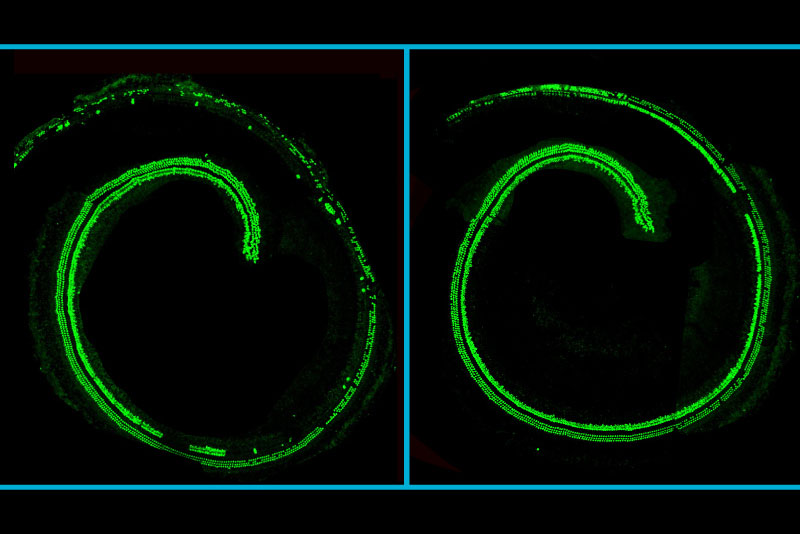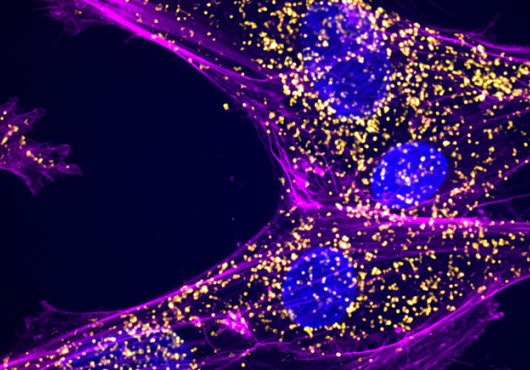
Hearing loss is the most common form of sensory loss in humans, and almost half of cases stem from genetic causes.
Now, a team led by researchers from Harvard Medical School, the Broad Institute of MIT and Harvard, Massachusetts Eye and Ear, Harvard University and Howard Hughes Medical Institute have successfully used gene editing to prevent hearing loss in a mouse model of human genetic progressive deafness.
A description of the team’s experiments and their findings are published in Nature.
The approach delivers a CRISPR-Cas9 gene-editing protein complex directly into the sound-sensing cells of the inner ear, known as hair cells, where it acts as a molecular scalpel and repairs a mutation that would otherwise cause the cells to die. The work represents the first time that a genome-editing protein has been ferried directly into the relevant cells to halt progression of genetic hearing loss. Delivering the Cas9 protein locally, instead of DNA elements that the cell can use to build Cas9, improved the precision of the approach.
“We set out to develop a genome-editing strategy to try to address this genetic hearing loss by disrupting the underlying genetic variant,” said co-senior author David Liu, the Richard Merkin Professor, director of the Merkin Institute of Transformative Technologies in Healthcare and core institute member at the Broad; professor of chemistry and chemical biology at Harvard University and an HHMI investigator. “A lot of additional work is needed before this strategy might inform the development of a therapy for humans, but at this stage, we’re delighted and excited that the treatment preserved some hearing in the animal model.”
Hair cells are the specialized inner ear cells that turn the mechanical vibrations of sound waves into electrical signals that the brain can interpret. One cause of genetic hearing loss is a single-letter mutation in a gene called TMC1 that causes hair cells to produce a malformed, toxic protein, which builds up over time and eventually kills the cell. People, and mice, with this mutation suffer progressive hearing loss during youth and eventually become profoundly deaf.
Because the mutated TMC1 gene differs from its normal counterpart by only a single letter of genetic code, Cas9 must target the mutated gene with exquisite precision to avoid cutting and disabling the functional copy of the gene instead.
With an eye toward improving editing precision, the team built on prior work published in 2014. When it comes to using CRISPR-Cas9 for gene editing, researchers typically insert the DNA encoding the Cas9 complex into a cell and let the cell use its own machinery to produce the gene-editing arsenal.
But Liu and colleagues previously demonstrated that if the Cas9 gene-editing complex was delivered directly into a cell, packaged inside an envelope of lipids, the editing was much more precise. Cas9 itself degrades quickly and generally cuts its exact target first before moving on to edit similar “off-target” DNA strands. In other words, when delivered as a protein complex, it usually breaks down before it has a chance to make those mistakes.
“The strategy we used was particularly efficient in targeting dominant genetic hearing loss,” said co-senior author Zheng-Yi Chen, HMS associate professor of otolaryngology at Mass. Eye and Ear. “In humans, dominant hearing loss generally manifests as late-onset and progressive, therefore providing us with a precious time window for intervention. The therapeutic effect through local inner ear delivery also presents a major advantage in reducing potential risks.”
The researchers tested the method in a mouse model of progressive hearing loss with a mutated TMC1 gene. Left untreated, the mice experience hearing loss by four weeks of age and profound deafness at eight. The team injected the gene-editing mix into the inner ears of newborn mice genetically destined for profound hearing loss.
The treated mice maintained a substantial amount of their hearing, compared with the untreated mice. At four weeks, the untreated mice had a measurable brainstem response to sound starting at roughly 80 decibels, the volume of a garbage disposal or loud radio. The treated mice, however, responded to sound starting at around 65 decibels—approximately the volume of a typical conversation.
Physiological measurements showed that the hair cells survived at a higher rate in the inner ears of treated animals. Genetic sequencing showed that among the edited cells the mutated copy of TMC1had successfully been disrupted 94 percent of the time. At eight weeks, treated mice also retained their instinctive physical startle response to sudden loud sound. The untreated mice did not respond.
“This is an exciting study that demonstrates the feasibility of a DNA-free, virus-free genome editing strategy for a type of autosomal dominant hearing loss characterized by progressive hair cell loss,” said Konstantina Stankovic, HMS associate professor of otolaryngology at Mass. Eye and Ear, who was not involved with the study. “Augmenting the toolbox to treat genetic deafness is of major significance.”
The team plans to develop the therapy in larger animal models of genetic progressive hearing loss.
“These results inform the potential development of a treatment for a subtype of genetic hearing loss, but making sure the method is safe and effective is critically important before we propose moving closer to human trials,” said Liu. “We also recognize the importance and remain mindful of cultural considerations within the deaf community as this work moves forward.”
This work was supported by the Defense Advanced Research Projects Agency (HR0011-17-2-0049), the National Institutes of Health (R01 EB022376, R35 GM118062, R01 DC006908, P30 DC05209, R01 DC00138 and R01 DC013521), the David-Shulsky Foundation, a Frederick and Ines Yeatts Hair Cell Regeneration grant, the Bertarelli Foundation, the Broad and HHMI.
Adapted from a joint Mass. Eye and Ear/Broad news release.





